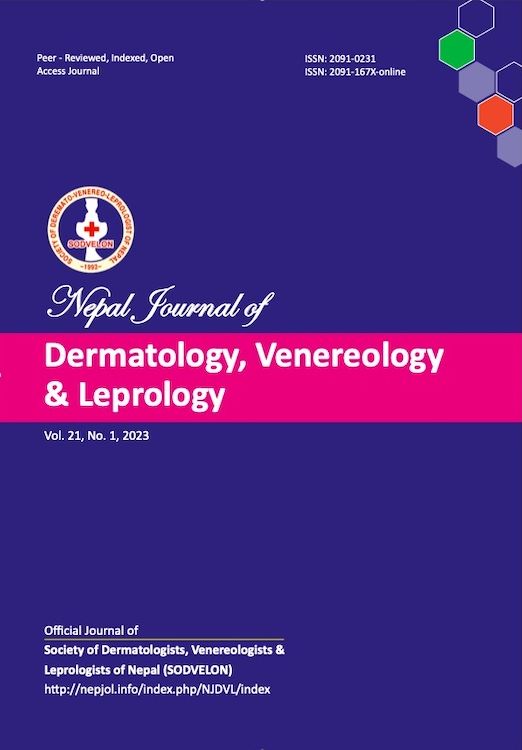Low Dose Oxybutin in Primary Hyperhydrosis: A Prospective Study from a Tertiary Care Center in Nepal
DOI:
https://doi.org/10.3126/njdvl.v21i1.48174Keywords:
Anti-cholinergic, Hyperhydrosis, Scoring system, OxybutinAbstract
Introduction: Hyperhydrosis is a clinical condition where there is excessive sweating beyond the physiological need of the patient’s body. This can directly or indirectly affect the quality of patients life. Oxybutin is widely used in urology as anticholinergic medication for bladder urge incontinence. It can be used safely at a high doses (over 15 mg/day) to treat urological disorder. It also acts against excessive sweating and can be used in cases of hyperhidrosis.
Objectives: To evaluate effectiveness of oxybutin at low dose and to assess the Hyperhidrosis Disease Severity Scale (HDSS) .
Materials and Methods: This is a hospital based cross-sectional study in primary hyperhydrosis. Oxybutin was prescribed to all patients of primary hyperhydrosis with gradual increment of dosage of 2.5 mg orally once a day to 5 mg twice a day. Patients were evaluated at zero wk (baseline), 4 wk, 8 wk, 12 wk and follow-up in 16 wks with Hyperhidrosis Disease Severity Scale (HDSS) along with adverse effects were noted.
Results: There was a significant difference in HDSS at zero wk (baseline) and 4th wk (p=0.001) at a dose of 2.5 mg once a day of oxybutynin. Also, a significant difference was noted (p=0.022) in HDSS between zero wk (baseline) and 12 wk. Similarly, a significant difference between HDSS at zero wk (baseline) versus the 16th wk was also noted.
Conclusion: Oxybutin is an anticholinergic drug with an emerging role in hyperhydrosis. Low doses have shown significant results with minimal side effects. The dose requirement varies among authors. Studies with long-term follow-ups with ideal protocol need to be established in the future.
Downloads
Downloads
Published
How to Cite
Issue
Section
License
Copyright (c) 2023 Society of Dermatologists, Venereologists and Leprologists of Nepal

This work is licensed under a Creative Commons Attribution 4.0 International License.
Copyright on any research article is transferred in full to Nepal Journal of Dermatology, Venereology & Leprology upon publication. The copyright transfer includes the right to reproduce and distribute the article in any form of reproduction (printing, electronic media or any other form).




